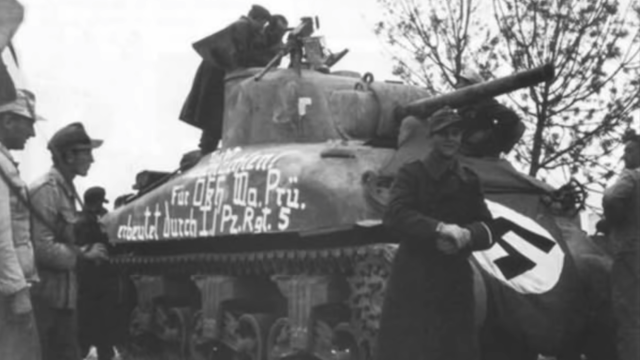In the final days of World War II, as U.S. troops advanced into Aschaffenberg, they encountered stiff German resistance in the form of something familiar: a Sherman tank, one of its beutepanzers, aka “loot tanks,” equipment seized in previous battles. In war, the loot can be as dangerous as anything.
Mark Felton, a prolific military history YouTuber, recently uploaded a new video about the U.S. Army’s unlikeliest of adversaries: M4 “Sherman” tanks. The Sherman medium tank was the most widely used tank of World War II. Designed and manufactured in the United States, it equipped the U.S. Army and U.S. Marine Corps and was lent in large numbers to the United Kingdom, Canada, France, Brazil, Poland, South Africa, Australia, and the Soviet Union.
German troops first encountered the Sherman in North Africa, where M4A1 tanks were captured from the U.S. 1st Armoured Division. U.S. Army troops, inexperienced in combat, turned in several less-than-stellar performances during the Tunisian campaign, particularly at the Battle of Sidi Bou Zid, and abandoned tanks and other equipment on the battlefield. The Germany Army shipped at least one Sherman home to Kummersdorf, home of the Wehrmacht’s weapon testing centre.
High ranking German officers and engineers took stock of the tank. The video shows a famous photo of Albert Speer, Minister of Armaments and War Production for the Reich, sitting in the commander’s hatch, seeing for himself what an American tank was all about. America was not known for its tanks at the time, and Yankee know-how in the fields of tank guns and armour were inferior to those of other countries.
Still, the Americans impressed the Germans by doing well what American cars were known for: the Germans found the Sherman well built, reliable, and comfortable. They were likely less impressed with the Sherman’s short barrel, low-velocity 75-millimetre gun, which was inferior to its German contemporary, the 75-millimetre KwK 40 L/43 that equipped the Panzer IV tank.
The German Army used large numbers of captured enemy tanks, beginning even before the war started 1938 with the Czechoslovakian Panzer 38t. Captured French tanks streamed into German inventories after the fall of France in 1940.
French tanks were used on the Eastern Front against the Soviet Union, in anti-guerilla operations, and given to weaker Axis partners such as Romania. They were also used to garrison Western Europe against an invasion by the Western Allies and possible landings in France. Polish, Dutch, and British tanks were all collected as spoils of war, with those captured In meaningful numbers converted to beutepanzers.
After Germany invaded the the Soviet Union in June 1941, it captured huge amounts of Soviet equipment. It pressed the Soviet T-34 tank pressed into service, despite the fact it had only a two-person turret and a garbage can-type lid for a commander’s turret hatch, seriously compromising the crew’s visibility.
The Germans added a cupola for the commander, allowing him to see in all directions while protected from enemy fire, painted a Balkan cross on the side, and sent it into battle. The Germans may have even used Sherman tanks on the Eastern Front, as the United States shipped more than 4,000 Shermans—with diesel instead of gasoline engines—for use by the Red Army.
Why did the Germans use so much foreign equipment? Hitler and the Nazi leadership were hesitant to fully mobilise the German economy for all-out war. Even the Nazis, hell-bent on world conquest, had to spread out its resources beyond buying military machines. Germany simply didn’t purchase enough tanks to make up for wartime losses. Berlin finally committed to a wartime economy in 1943, only after it became clear that the war with Russia was unwinnable.
The “loot tanks” concept didn’t die with Hitler’s army, though. Fighting forces were commandeering vehicles before WWII and have continued to do so since.
Even as recently as 2018, the Pentagon acknowledged that nine Iraqi Army M1A1 Abrams tanks fell into the hands of the Popular Mobilisation Forces, an Iraqi Shiite militia with ties to Iran.
The tanks were reportedly later returned to the Iraqi Army. The Islamic State briefly operated Iraqi Abrams tanks before U.S. forces destroyed them with airstrikes.
As long as there are battlefields to loot, beutepanzers will always be a problem.
